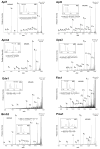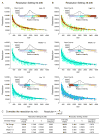Resolving the composition of protein complexes using a MALDI LTQ Orbitrap
- PMID: 19822444
- PMCID: PMC2820827
- DOI: 10.1016/j.jasms.2009.08.026
Resolving the composition of protein complexes using a MALDI LTQ Orbitrap
Abstract
Current biological studies have been advanced by the continuous development of robust, accurate, and sensitive mass spectrometric technologies. The MALDI LTQ Orbitrap is a new addition to the Orbitrap configurations, known for their high resolving power and accuracy. This configuration provides features inherent to the MALDI source, such as reduced spectra complexity, forgiveness to contaminants, and sample retention for follow-up analyses with targeted or hypothesis-driven questions. Here we investigate its performance for characterizing the composition of isolated protein complexes. To facilitate the assessment, we selected two well characterized complexes from Saccharomyces cerevisiae, Apl1 and Nup84. Manual and automatic MS and MS/MS analyses readily resolved their compositions, with increased confidence of protein identification compared with our previous reports using MALDI QqTOF and MALDI IT. CID fragmentation of singly-charged peptides provided sufficient information for conclusive identification of the isolated proteins. We then assessed the resolution, accuracy, and sensitivity provided by this instrument in the context of analyzing the isolated protein assemblies. Our analysis of complex mixtures of singly-charged ions up to m/z 4000 showed that (1) the resolving power, inversely proportional to the square root of m/z, had over four orders of magnitude dynamic range; (2) internal calibration led to improved accuracy, with an average absolute mass error of 0.5 ppm and a distribution centered at 0 ppm; and (3) subfemtomole sensitivity was achieved using both CHCA and DHB matrices. Additionally, our analyses of a synthetic phosphorylated peptide in mixtures showed subfemtomole level of detection using neutral loss scanning.
2010 American Society for Mass Spectrometry. Published by Elsevier Inc. All rights reserved.
Figures





Similar articles
-
Peptides quantification by liquid chromatography with matrix-assisted laser desorption/ionization and selected reaction monitoring detection.J Proteome Res. 2012 Oct 5;11(10):4972-82. doi: 10.1021/pr300514u. Epub 2012 Aug 31. J Proteome Res. 2012. PMID: 22897511
-
Matrix ions as internal standard for high mass accuracy matrix-assisted laser desorption/ionization mass spectrometry imaging.Rapid Commun Mass Spectrom. 2021 Aug 30;35(16):e9110. doi: 10.1002/rcm.9110. Rapid Commun Mass Spectrom. 2021. PMID: 33880828
-
In Situ characterization of proteins using laserspray ionization on a high-performance MALDI-LTQ-Orbitrap mass spectrometer.J Am Soc Mass Spectrom. 2014 Dec;25(12):2177-80. doi: 10.1007/s13361-014-0986-9. Epub 2014 Oct 2. J Am Soc Mass Spectrom. 2014. PMID: 25273590 Free PMC article.
-
The identification of protein-protein interactions of the nuclear pore complex of Saccharomyces cerevisiae using high throughput matrix-assisted laser desorption ionization time-of-flight tandem mass spectrometry.Mol Cell Proteomics. 2002 Jun;1(6):434-50. doi: 10.1074/mcp.m200027-mcp200. Mol Cell Proteomics. 2002. PMID: 12169684
-
Matrix-assisted laser desorption/ionization mass spectrometry method for selectively producing either singly or multiply charged molecular ions.Anal Chem. 2010 Jan 1;82(1):11-5. doi: 10.1021/ac902066s. Anal Chem. 2010. PMID: 19904915
Cited by
-
Proteomic characterization of pseudorabies virus extracellular virions.J Virol. 2011 Jul;85(13):6427-41. doi: 10.1128/JVI.02253-10. Epub 2011 Apr 27. J Virol. 2011. PMID: 21525350 Free PMC article.
-
Proteomics-based methods for discovery, quantification, and validation of protein-protein interactions.Anal Chem. 2013 Jan 15;85(2):749-68. doi: 10.1021/ac3033257. Epub 2012 Dec 12. Anal Chem. 2013. PMID: 23157382 Free PMC article. Review. No abstract available.
-
The response regulator SprE (RssB) is required for maintaining poly(A) polymerase I-degradosome association during stationary phase.J Bacteriol. 2010 Jul;192(14):3713-21. doi: 10.1128/JB.00300-10. Epub 2010 May 14. J Bacteriol. 2010. PMID: 20472786 Free PMC article.
-
A conserved coatomer-related complex containing Sec13 and Seh1 dynamically associates with the vacuole in Saccharomyces cerevisiae.Mol Cell Proteomics. 2011 Jun;10(6):M110.006478. doi: 10.1074/mcp.M110.006478. Epub 2011 Mar 31. Mol Cell Proteomics. 2011. PMID: 21454883 Free PMC article.
-
A proteomic approach provides new insights into the control of soil-borne plant pathogens by Bacillus species.PLoS One. 2013;8(1):e53182. doi: 10.1371/journal.pone.0053182. Epub 2013 Jan 3. PLoS One. 2013. PMID: 23301041 Free PMC article.
References
-
- Alber F, Dokudovskaya S, Veenhoff LM, Zhang W, Kipper J, Devos D, Suprapto A, Karni-Schmidt O, Williams R, Chait BT, Rout MP, Sali A. Determining the architectures of macromolecular assemblies. Nature. 2007;450(7170):683–94. - PubMed
-
- Alber F, Dokudovskaya S, Veenhoff LM, Zhang W, Kipper J, Devos D, Suprapto A, Karni-Schmidt O, Williams R, Chait BT, Sali A, Rout MP. The molecular architecture of the nuclear pore complex. Nature. 2007;450(7170):695–701. - PubMed
-
- Karas M, Hillenkamp F. Laser desorption ionization of proteins with molecular masses exceeding 10,000 daltons. Anal Chem. 1988;60(20):2299–301. - PubMed
-
- Hillenkamp F, Karas M, Beavis RC, Chait BT. Matrix-assisted laser desorption/ionization mass spectrometry of biopolymers. Anal Chem. 1991;63(24):1193A–1203A. - PubMed
Publication types
MeSH terms
Substances
Grants and funding
LinkOut - more resources
Full Text Sources
Molecular Biology Databases

